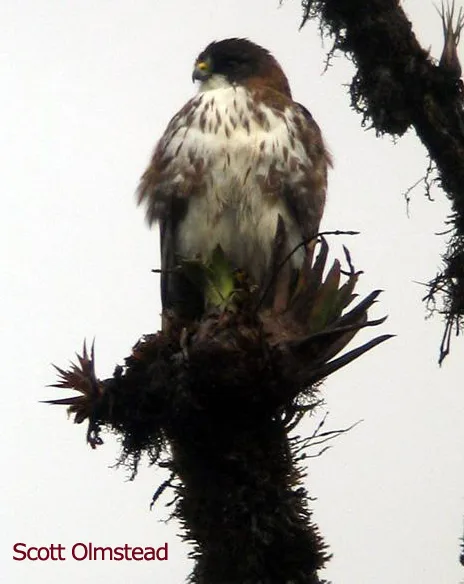
White-throated Hawk
[order] ACCIPITRIFORMES | [family] Accipitridae | [latin] Buteo albigula | [authority] Philippi, 1899 | [UK] White-throated Hawk | [FR] Buse a gorge blanche | [DE] Weisskehl-Bussard | [ES] Busardo Gorgiblanco | [NL] Witkeelbuizerd
Subspecies
| Genus | Species | subspecies | Region | Range |
| Buteo | albigula | SA | Venezuela to c Chile |
Genus
Members of the genus Buteo are broad-winged, broad-tailed hawks, Well adapted for soaring. The bill, legs and talons are of average proportions. There is much colour variation both within the species, and, by way of phases, within individual species. In all cases the young are quite different from adults in that they are all well camouflaged with an overall brown appearance with varying amounts of striping below and paler mottling above.
The 25 species are spread worldwide with the exception of Australasia and much of the Indian sub-continent.
Physical charateristics
This species is dark brown above and largely white below. Unlike the similar Broad-winged Hawk (Buteo platypterus), White-throated has streaking confined largely to the sides of the breast and flanks, giving it a semi-collared appearance.
Listen to the sound of White-throated Hawk
[audio:https://planetofbirds.com/MASTER/ACCIPITRIFORMES/Accipitridae/sounds/White-throated Hawk.mp3]
Copyright remark: Most sounds derived from xeno-canto
| wingspan min.: | 90 | cm | wingspan max.: | 100 | cm |
| size min.: | 38 | cm | size max.: | 48 | cm |
| incubation min.: | 27 | days | incubation max.: | 33 | days |
| fledging min.: | 35 | days | fledging max.: | 45 | days |
| broods: | 1 | eggs min.: | 1 | ||
| eggs max.: | 3 |
Range
South America : Venezuela to Central Chile
Habitat
Occurs at middle and montane elevations, but occasionally ranges lower in the southern portion of breeding range in Chile and Argentina. In its breeding range, this is an indicator species of temperate southern beech (Nothofagus) forests from 900-1,600 m elevation. In its winter range in Colombia, it is found in humid montane forest, especially low or elfin forest above 2,500 m
Reproduction
Builds a stick nest placed on a cliff or in a tree, usually a Nothofagus, in Argentina and Chile, but one nest was in a “peumo” (Cryptocarpa alba) tree in Chile. Nests are often re-used, growing larger with each successive season. Clutch size is 1-3 eggs, Most, but not all, incubation is done by the female, and most prey is delivered to the nest by the male. The incubation period lasts for about one month, and the nestling period is about six weeks.
Feeding habits
Feeds on birds, rodents, snakes, and lizards during the breeding season, and adults also provided these prey items to nestlings. Hunting techniques include hovering, quartering flights, and low-level flights in pursuit of avian prey, especially along ridgetops.
Conservation
This species has a very large range, and hence does not approach the thresholds for Vulnerable under the range size criterion (Extent of Occurrence <20,000 km2 combined with a declining or fluctuating range size, habitat extent/quality, or population size and a small number of locations or severe fragmentation). The population trend is not known, but the population is not believed to be decreasing sufficiently rapidly to approach the thresholds under the population trend criterion (>30% decline over ten years or three generations). The population size may be small, but it is not believed to approach the thresholds for Vulnerable under the population size criterion (<10,000 mature individuals with a continuing decline estimated to be >10% in ten years or three generations, or with a specified population structure). For these reasons the species is evaluated as Least Concern.

Migration
Partial migrant, according to Bildstein (2006), although at least some populations are apparently completely migratory. This species is also an altitudinal migrant in some areas. The species is known to be a summer breeding resident in the southern temperate forests of Argentina and Chile it appears that flocks move north in autumn and south in spring in central Chile.
Distribution map

